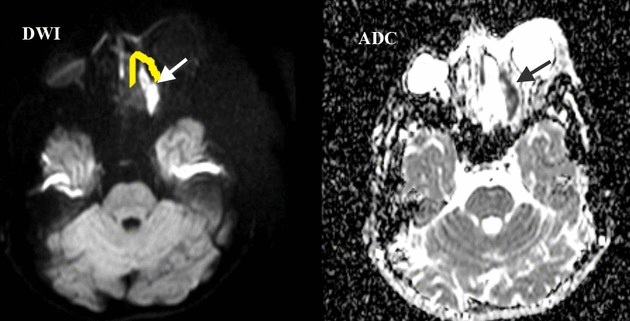Orbital cellulitis MRI
Editor-In-Chief: C. Michael Gibson, M.S., M.D. [1]; Associate Editor(s)-in-Chief: Tarek Nafee, M.D. [2]
|
Orbital cellulitis Microchapters |
|
Diagnosis |
|---|
|
Treatment |
|
Case Studies |
|
Orbital cellulitis MRI On the Web |
|
American Roentgen Ray Society Images of Orbital cellulitis MRI |
|
Risk calculators and risk factors for Orbital cellulitis MRI |
Overview
On MRI scan of the head, orbital cellulitis is characterized by hypointense signal on T1-weighted fat-suppressed images, and hyperintense signal on T2-weighted fat-suppressed images.[1] MRI has demonstrated equivalence to CT in diagnosing orbital disease and is equally accepted as a gold standard diagnostic imaging modality.[2][3] Although an MRI scan is safer in children since there is no radiation exposure, the long acquisition time and the need for prolonged sedation make CT scans the imaging modality of choice.[2][4]
MRI
Key MRI Findings in Orbital Cellulitis
On MRI scan of the head, orbital cellulitis is characterized by hypointense signal on T1-weighted images, and hyperintense signal on T2-weighted images.[1] MRI has demonstrated equivilance to CT in diagnosing orbital disease and is equally accepted as a gold standard diagnostic imaging modality.[2][3] Although an MRI scan is safer in children since there is no radiation exposure, the long acquisition time and the need for prolonged sedation make CT scan the imaging modality of choice.[4] After a diagnosis is made, MRI has shown superiority in assessing the severity of intracranial involvement and abscess border visualization.[5]
MRI scans characterize subperiosteal and orbital abscesses on T1-weighted images with contrast as a rim-enhancing lesion.[1] Additionally, diffuse weighted imaging (DWI) has shown promise of a non-contrast option for detection of orbital cellulitis and abscesses on MRI.[2][3][6][7][8]
MRI Examples of Orbital Cellulitis
Examples of orbital cellulitis on MRI:[1]
References
- ↑ 1.0 1.1 1.2 1.3 Radiopaedia (2016)http://radiopaedia.org/articles/orbital-infection
- ↑ 2.0 2.1 2.2 2.3 Sepahdari AR, Aakalu VK, Kapur R, Michals EA, Saran N, French A; et al. (2009). "MRI of orbital cellulitis and orbital abscess: the role of diffusion-weighted imaging". AJR Am J Roentgenol. 193 (3): W244–50. doi:10.2214/AJR.08.1838. PMID 19696266.
- ↑ 3.0 3.1 3.2 Merck Manual Professional Edition (2016)https://www.merckmanuals.com/professional/eye-disorders/orbital-diseases/preseptal-and-orbital-cellulitis
- ↑ 4.0 4.1 American Academy of Ophthalmology EyeWiki (2015)http://eyewiki.aao.org/Orbital_Cellulitis#Diagnostic_procedures
- ↑ Mair MH, Geley T, Judmaier W, Gassner I (2002). "Using orbital sonography to diagnose and monitor treatment of acute swelling of the eyelids in pediatric patients". AJR Am J Roentgenol. 179 (6): 1529–34. doi:10.2214/ajr.179.6.1791529. PMID 12438049.
- ↑ Chaudhry IA, Al-Rashed W, Arat YO (2012). "The hot orbit: orbital cellulitis". Middle East Afr J Ophthalmol. 19 (1): 34–42. doi:10.4103/0974-9233.92114. PMC 3277022. PMID 22346113.
- ↑ LeBedis CA, Sakai O (2008). "Nontraumatic orbital conditions: diagnosis with CT and MR imaging in the emergent setting". Radiographics. 28 (6): 1741–53. doi:10.1148/rg.286085515. PMID 18936033.
- ↑ Yousem DM (1993). "Imaging of sinonasal inflammatory disease". Radiology. 188 (2): 303–14. doi:10.1148/radiology.188.2.8327669. PMID 8327669.
